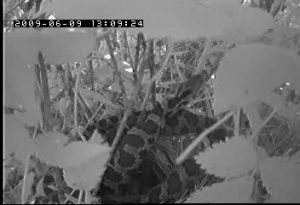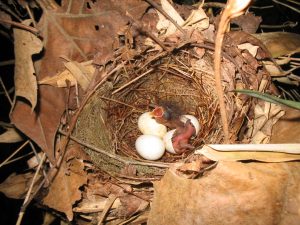Habitat Selection and its Demographic and Physiological Consequences
Much of our research focuses on understanding habitat selection to inform conservation and management decision making. Primarily focusing on conservation-priority bird  species, we’re interested in the roles of vegetation structure and composition, food resources, landscape context, natural and human-caused disturbances, abiotic factors, and management and restoration actions on habitat use and demographic performance. We’ve been particularly interested in mechanisms of nest predation, including what features of nest sites make them more or less vulnerable to a variety of nest predator species. In recent years, we’ve expanded beyond focusing on reproductive success and survival to also include sub-lethal effects using various physiological metrics, including evaluation of hormones in eggs and both hormones and immune function in nestling and adult birds.
species, we’re interested in the roles of vegetation structure and composition, food resources, landscape context, natural and human-caused disturbances, abiotic factors, and management and restoration actions on habitat use and demographic performance. We’ve been particularly interested in mechanisms of nest predation, including what features of nest sites make them more or less vulnerable to a variety of nest predator species. In recent years, we’ve expanded beyond focusing on reproductive success and survival to also include sub-lethal effects using various physiological metrics, including evaluation of hormones in eggs and both hormones and immune function in nestling and adult birds.
Ecology of Avian Reproduction
 Beyond the primarily applied aspects of our work on bird-habitat relationships, we’re also interested in fundamental questions about reproduction in birds. Topics of interest include how birds perceive and respond to nest predation risk, the influence of incubation temperature on development and subsequent consequences for nestlings, and how nest composition and structure influence the thermal environment of eggs and nestlings. We’ve also been interested in the vocal and movement behaviors of birds during the breeding season.
Beyond the primarily applied aspects of our work on bird-habitat relationships, we’re also interested in fundamental questions about reproduction in birds. Topics of interest include how birds perceive and respond to nest predation risk, the influence of incubation temperature on development and subsequent consequences for nestlings, and how nest composition and structure influence the thermal environment of eggs and nestlings. We’ve also been interested in the vocal and movement behaviors of birds during the breeding season.
Avian Migration Ecology
 In addition to our work on breeding birds, we’ve also been interested in the ecology of birds during migratory periods. Past and ongoing work includes focus on habitat use, stopover duration, movement ecology, and survival of both game and non-game birds during both spring and fall migrations.
In addition to our work on breeding birds, we’ve also been interested in the ecology of birds during migratory periods. Past and ongoing work includes focus on habitat use, stopover duration, movement ecology, and survival of both game and non-game birds during both spring and fall migrations.
Long-term Trends in Animal and Plant Populations
Working closely with natural resource agencies, we aim to examine long-term population trends and potential drivers of these trends. This has included working with  both historic and contemporary data on bird populations, as well as long-term and spatially extensive datasets on plant, arthropod, and fur-bearer populations. In addition to seeking a better understanding of the roles of habitat loss, invasive species, and environmental stressors on changes in populations, we aim to examine the potential role of natural resource decision making in affecting these populations.
both historic and contemporary data on bird populations, as well as long-term and spatially extensive datasets on plant, arthropod, and fur-bearer populations. In addition to seeking a better understanding of the roles of habitat loss, invasive species, and environmental stressors on changes in populations, we aim to examine the potential role of natural resource decision making in affecting these populations.

